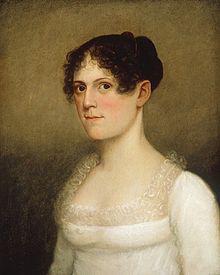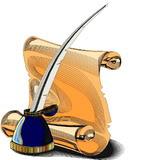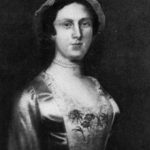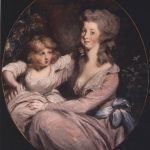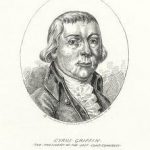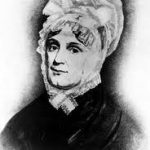Daughter of Vice President Aaron Burr
Theodosia Burr Alston (1783–1813) was a brilliant, independent and highly-educated woman in an age which valued none of those traits in females. From her birth into New York’s high society, her childhood among the leaders of the new nation, her marriage to a Southern slaveholding aristocrat, to her mysterious disappearance at sea, Theodosia Burr Alston’s life was quite unique for a woman in 19th century America.
Childhood and Early Years
Theodosia Burr was born on June 21, 1783 in Albany, New York, the daughter of Theodosia Prevost Burr and the controversial U.S. Vice President Aaron Burr. Burr had distinguished himself as an officer in the Revolutionary War, during which he became a member of General George Washington‘s inner circle.
Young Theodosia’s education was closely supervised by her father, but she was not trained to serve hearth, home or plantation. In addition to the more conventional subjects like French, music and dancing, she studied arithmetic, languages and English composition. This type of tutoring was very rarely given to girls of Theodosia’s generation. A child prodigy, Theodosia spoke Latin, French, German, and read Greek by the age of twelve.
After her mother died when she was only ten, Theodosia became Aaron Burr’s closest confidante, and spent most of her unmarried life in New York City with her charismatic, influential father. Burr also closely supervised his daughter’s social training in an appreciation of the arts and the intangibles of relating to other people. By the age of 14 Theodosia began to serve as hostess at Richmond Hill, Aaron Burr’s country estate in what is now Greenwich Village.
She supported her father’s rising political career by hosting grand parties at the estate. Thomas Jefferson and Alexander Hamilton were among the regular visitors; Theodosia was charming and gracious to them all. In the presidential election of 1800, Burr and Thomas Jefferson received the same number of electoral votes. To Burr’s chagrin, Congress voted to make him Vice President.
Marriage and Family
Theodosia had many suitors, but the one who captured her heart was Joseph Alston, a dashing young Southern heir to a rice-planting fortune. On the evening of February 2, 1801, Theodosia Burr married Alston. They honeymooned briefly at Burr’s Richmond Hill mansion, and then traveled to Washington, where they watched Aaron Burr inaugurated as Vice President on March 4, 1801.
Joseph and Theodosia then continued south to The Oaks, Alston’s ancestral home near Georgetown, South Carolina. Despite substantial cultural differences, the marriage thrived. She loved her husband, but often missed her New York home, and especially her father. She wrote to him that the hot, humid climate and swampy Low Country was no match for the beauty of the Hudson River Valley.
It has been suggested that there was more than romance involved in this union. Aaron Burr agonized intensely and daily about money matters, particularly as to how he would hold on to the Richmond Hill estate. It is thought that his daughter’s tie to a member of the Southern gentry might relieve him of some of his financial burdens.
In May 1802, after a very difficult labor, Theodosia gave birth to a son, Aaron Burr Alston. The birth resulted in debilitating medical problems untreatable in her time, leaving Theodosia to live out the rest of her married life infertile and battling recurring bouts of illness. She made trips to Saratoga, New York and Ballston Spa in an effort to restore her health, but with no lasting effects.
Soon after their marriage, Joseph Alston had been elected to the state House of Representatives and was frequently away from home for extended periods of time. Theodosia’s great love became her son. A lively and talented child, young Aaron became the object of adoration for his parents and grandparents.
In 1804, Aaron Burr’s political career disintegrated. The rivalry between Burr and Alexander Hamilton descended into a war of personal insults waged in the northern newspapers until Burr challenged Hamilton to a duel, during which Burr killed the former Secretary of the Treasury. The event elevated Hamilton to national hero status and destroyed Burr’s reputation.
Burr was charged with murder and put on trial. Throughout the ordeal, Theodosia stood by her father. She traveled to New York several times during the long trial and was elated when he was finally acquitted. But Burr became a bitter man who longed for political power.
Theodosia accompanied her father to Ohio in the summer of 1806. There Aaron Burr met Irishman Harman Blennerhassett, and they were later joined by General James Wilkinson. These men were rumored to be planning to encourage Louisiana and other western states to secede from the Union and form a separate empire, with Burr as emperor and Theodosia as empress.
The whole fiasco was more talk than action, but when word of Burr’s activities reached President Jefferson, Burr was denounced as a traitor and tried for treason in 1807. And again, Theodosia decried his innocence. After an arduous yearlong trial, Burr was once again acquitted, but his reputation was destroyed. Burr left the country, a once-powerful leader in voluntary exile.
Theodosia returned to South Carolina, the ordeal adding to her increasingly frail health. The final blow came in June 1812, when her son died of malaria at age ten. Theodosia went into a deep depression, and her already fragile health declined over the next several months as she mourned the loss of her son, and her father was still living abroad. It was a very difficult time.
The Voyage
Aaron Burr returned to the United States in 1812, and in December of that year convinced Theodosia to come to New York for a visit. It would be their first meeting in five years. However, Joseph Alston was reluctant to allow her to make the trip. The country was again at war with Britain and Theodosia’s health was still fragile.
Alston had just been elected governor of South Carolina and could not leave the state in time of war. However, Theodosia insisted on making the trip, and Alston used his connections to get a letter to the British Navy, which was blockading the coast, requesting safe passage for his wife. Aaron Burr sent Timothy Green, a trusted physician and friend, to accompany his daughter north.
Plans were made for Theodosia to sail aboard the schooner, Patriot. This ship was a privateer, one of a flotilla of privately owned vessels hired by the American government to harass blockading British ships and capture the cargoes of merchant mariners during the War of 1812. The Patriot was in from several months of privateering, and her hold was filled with loot from raids in the West Indies.
In order to disguise the ship’s true identity for the voyage to New York, the captain stowed the guns below deck, painted over the ship’s name on the bow, and completely erased any indication of recent activity. Theodosia, her maid and Dr. Green boarded the schooner at Georgetown, South Carolina late on the afternoon of December 31, 1812. Soon thereafter the Patriot lifted anchor and set sail for the open sea.
The Mystery
The ocean voyage from South Carolina to New York normally took five or six days. After two weeks had passed with no sign of Theodosia or the ship, Joseph Alston and Aaron Burr became frantic. Alston wrote, “Another mail and still no letter! I hear too rumors of a gale off Cape Hatteras [North Carolina] at the beginning of the month. The state of my mind is dreadful!”
In New York, Theodosia’s father refused to credit any of the rumors of her possible capture, choosing to believe that she had died at sea. When a friend offered hope that Theodosia was still alive, Burr replied, “No, no, she is indeed dead. Were she still alive, all the prisons in the world could not keep her from her father.”
The Patriot had disappeared without a trace; its fate remains a mystery. It was later learned that the British fleet had stopped her off Cape Hatteras on January 2, 1813. Governor Alston’s letter had worked, and the schooner was allowed to pass. Later that night, a gale arose and scattered the British fleet. Beyond that clue, no more was known. Burr sent searchers to Nassau and Bermuda with no success.
Theodosia Burr Alston most likely died at sea on January 2 or 3, 1813.
Both her husband and father were inconsolable in their grief. Joseph Alston never recovered from his wife’s disappearance. He would sit for hours in Theodosia’s bedroom in a severe state of depression. Three years later Alston was stricken with a seizure, which cost him his life. Aaron Burr lived until 1836, dying in nearly penniless obscurity.
Possible Explanations
Following the Patriot‘s disappearance, rumors immediately arose. The most enduring was that the ship had been captured by pirates. For hundreds of years, pirates had been frequent visitors to the Outer Banks of North Carolina and a few of the most infamous called the coastline home. One legend tells of Theodosia suffering a state of psychosis after witnessing the murder of the Patriot crew at the hands of pirates.
One story which was considered somewhat plausible was that the Patriot had fallen prey to the wreckers known as the Carolina bankers who populated the sandbank islands near Nags Head, North Carolina. On stormy nights the bankers would hobble a horse, tie a lantern around the animal’s neck, and walk it up and down the beach.
Ships in the area would head towards the light, believing they were following a ship through the treacherous shoals to safety. In actuality, the pirates were luring ships into the breakers and shallow waters, causing them to run aground close enough for the pirates to board and commandeer the vessel and its cargo.
An analysis of the known facts has led some scholars to conclude that the Patriot was probably wrecked by a storm off Cape Hatteras, the “Graveyard of the Atlantic.” Logbooks from the blockading British fleet report a severe storm which began off the North Carolina coast in the afternoon of January 2, 1813, and continued into the next day. The Patriot was likely just north of Cape Hatteras when the storm was at its fiercest.
SOURCES
The Fate of Theodosia Burr
Wikipedia: Theodosia Burr Alston
Theodosia Burr Alston: Portrait of a Prodigy
Theodosia Burr Alston: The Carolina Coast
